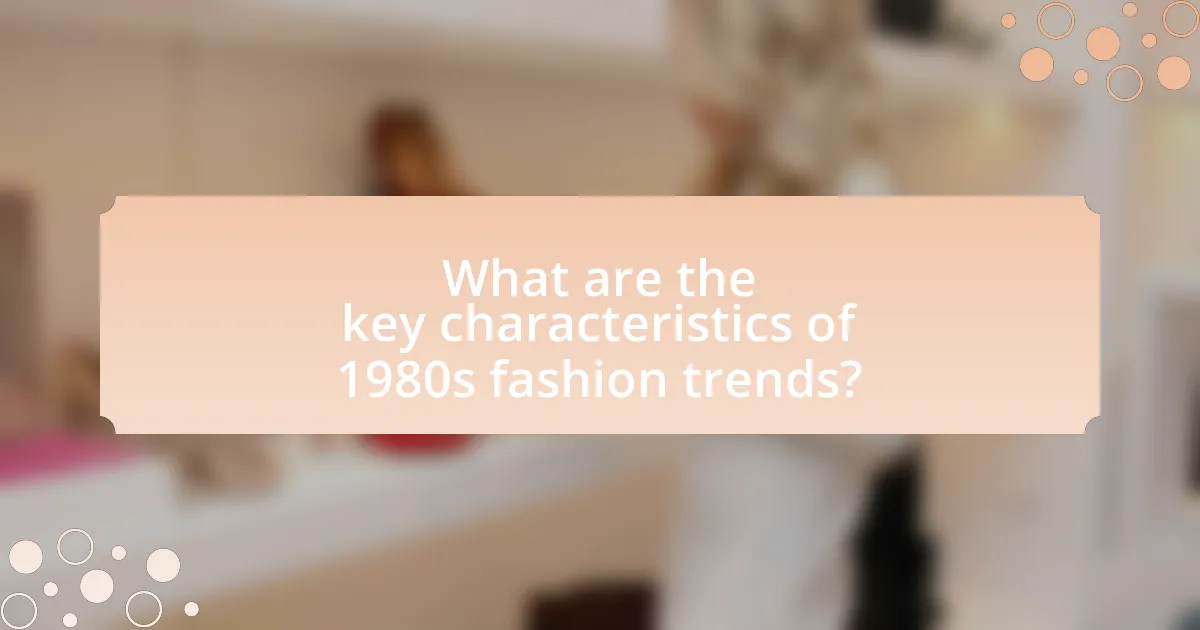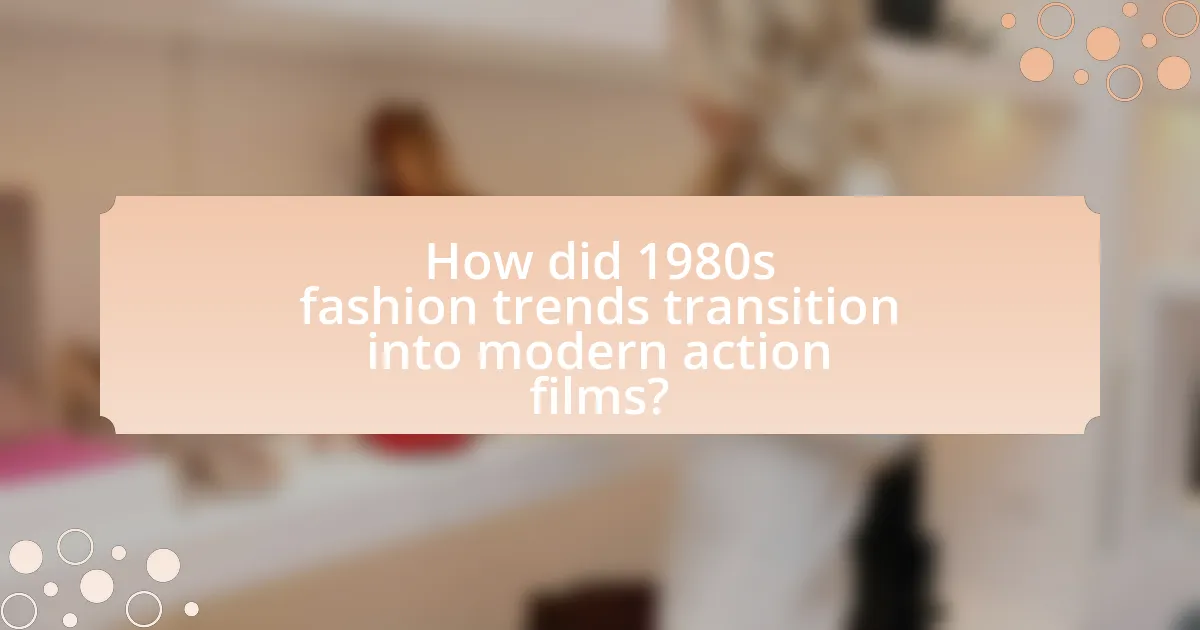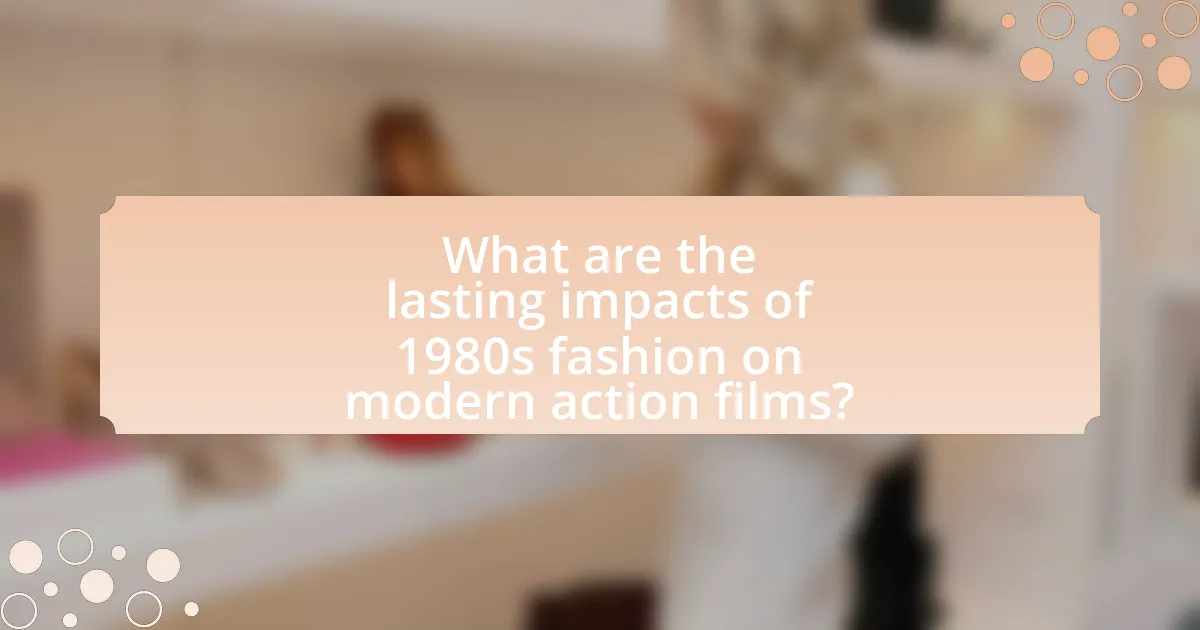The article examines the significant impact of 1980s fashion trends on modern action films, highlighting key characteristics such as bold colors, oversized silhouettes, and eclectic styles that defined the decade. It explores how iconic figures and pop culture influenced these trends, shaping public perception and consumer behavior. The discussion includes the role of major fashion designers, the integration of 1980s aesthetics in contemporary cinema, and the lasting effects on character development and storytelling in films. Additionally, it addresses the cultural implications of revisiting 1980s fashion and offers insights for filmmakers on balancing nostalgia with originality in their work.

What are the key characteristics of 1980s fashion trends?
The key characteristics of 1980s fashion trends include bold colors, oversized silhouettes, and eclectic styles. This decade saw the rise of vibrant neon hues, often paired with black, creating a striking visual impact. Oversized clothing, such as baggy jeans, shoulder pads, and large blazers, became popular, reflecting a sense of power and confidence. Additionally, the influence of pop culture icons, such as Madonna and Prince, led to a mix of styles that combined punk, glam rock, and athletic wear. The use of accessories like leg warmers, chunky jewelry, and headbands further defined the era’s distinctive look. These elements collectively contributed to a fashion landscape that was both expressive and diverse, shaping trends that continue to influence modern fashion.
How did 1980s fashion influence popular culture?
1980s fashion significantly influenced popular culture by introducing bold styles, vibrant colors, and distinctive silhouettes that became emblematic of the era. This fashion revolution was characterized by the rise of power dressing, with oversized blazers, shoulder pads, and high-waisted jeans becoming staples in both everyday wear and media representations. The influence extended to music, film, and television, where icons like Madonna and Prince showcased these trends, shaping public perception and consumer behavior. The popularity of films such as “Flashdance” and “The Breakfast Club” further solidified these fashion choices, as they depicted youth culture and aspirations, leading to a lasting impact on fashion trends in subsequent decades.
What specific styles emerged during the 1980s fashion era?
The specific styles that emerged during the 1980s fashion era include power suits, oversized silhouettes, and bold colors. Power suits, characterized by shoulder pads and tailored cuts, symbolized women’s empowerment in the workplace, reflecting the rise of female professionals. Oversized silhouettes, such as baggy jeans and large graphic tees, became popular among youth culture, influenced by hip-hop and punk movements. Bold colors and patterns, including neon shades and geometric prints, were prevalent in both casual and formal wear, driven by the vibrant pop culture of the decade. These styles collectively shaped the visual identity of the 1980s and continue to influence modern fashion trends.
How did music and film shape 1980s fashion trends?
Music and film significantly shaped 1980s fashion trends by popularizing distinctive styles that reflected the cultural zeitgeist of the era. Iconic musicians like Madonna and Prince influenced clothing choices with bold colors, extravagant accessories, and unique silhouettes, while films such as “Flashdance” and “The Breakfast Club” showcased casual yet edgy looks that resonated with youth culture. For instance, the leg warmers and off-the-shoulder tops featured in “Flashdance” became fashion staples, illustrating how cinematic portrayals directly impacted consumer trends. Additionally, the rise of music videos on platforms like MTV further amplified these styles, creating a visual culture that merged music and fashion, leading to a lasting legacy in both industries.
What role did iconic figures play in 1980s fashion?
Iconic figures played a pivotal role in shaping 1980s fashion by influencing trends through their public personas and media presence. Celebrities such as Madonna, Prince, and Michael Jackson set style standards that were widely emulated, with Madonna popularizing lace, bold accessories, and layered clothing, while Michael Jackson’s military jackets and single white glove became iconic fashion statements. These figures not only showcased unique styles but also contributed to the commercialization of fashion, as their influence led to the rise of designer brands and the integration of music and fashion industries. The visibility of these trends in music videos and films further solidified their impact, making 1980s fashion a defining element of pop culture that continues to resonate in modern action films.
Who were the major fashion designers of the 1980s?
The major fashion designers of the 1980s included Gianni Versace, Yves Saint Laurent, and Jean-Paul Gaultier. Gianni Versace was known for his bold prints and vibrant colors, which became synonymous with the era’s opulence. Yves Saint Laurent revolutionized women’s fashion with his tuxedo jacket for women, blending masculine and feminine styles. Jean-Paul Gaultier gained fame for his avant-garde designs and use of unconventional materials, notably his iconic corset worn by Madonna. These designers significantly influenced the fashion landscape of the 1980s, shaping trends that are still referenced in modern action films.
How did celebrities influence fashion choices in the 1980s?
Celebrities significantly influenced fashion choices in the 1980s by setting trends that were widely emulated by the public. Icons such as Madonna and Prince popularized bold styles, including vibrant colors, oversized clothing, and unique accessories, which became synonymous with the decade. The rise of music videos and television shows showcased these celebrities, amplifying their impact on fashion. For instance, Madonna’s “Like a Virgin” performance introduced lace gloves and layered necklaces, leading to widespread adoption of similar looks. Additionally, actors in blockbuster films, like those in “Flashdance” and “Top Gun,” further shaped fashion trends by featuring distinctive outfits that resonated with audiences, solidifying the connection between celebrity culture and fashion in the 1980s.

How did 1980s fashion trends transition into modern action films?
1980s fashion trends transitioned into modern action films through the incorporation of bold colors, oversized silhouettes, and distinctive accessories that characterized the era. Iconic elements such as leather jackets, high-waisted pants, and vibrant athletic wear have been reinterpreted in contemporary action films, reflecting a nostalgic homage to the 1980s. For instance, films like “John Wick” and “Deadpool” showcase tailored suits and combat boots reminiscent of 1980s action heroes, while also integrating modern aesthetics. This blending of styles not only appeals to audiences’ sense of nostalgia but also reinforces the cultural significance of 1980s fashion in shaping character identities and visual storytelling in today’s cinema.
What elements of 1980s fashion are evident in contemporary action films?
Contemporary action films prominently feature elements of 1980s fashion, such as bold colors, oversized silhouettes, and athletic wear. These characteristics are evident in the use of vibrant neon colors and graphic prints, which reflect the 1980s aesthetic. Additionally, the trend of incorporating high-waisted pants and shoulder pads can be observed in the styling of characters, echoing the power-dressing movement of that era. The resurgence of accessories like scrunchies and chunky jewelry further emphasizes this connection. Films like “Stranger Things” and “Atomic Blonde” showcase these fashion elements, reinforcing the nostalgic influence of 1980s style on modern cinematic narratives.
Which specific films showcase 1980s fashion influences?
Specific films that showcase 1980s fashion influences include “The Breakfast Club,” “Ferris Bueller’s Day Off,” and “Back to the Future.” “The Breakfast Club” features iconic styles such as high-waisted jeans and colorful accessories, reflecting the youth culture of the decade. “Ferris Bueller’s Day Off” showcases preppy looks and casual attire that were popular among teenagers, while “Back to the Future” highlights the era’s distinctive clothing, including denim jackets and vibrant patterns. These films collectively illustrate the diverse fashion trends that defined the 1980s and continue to influence modern fashion.
How do costume designers incorporate 1980s styles in modern films?
Costume designers incorporate 1980s styles in modern films by utilizing bold colors, oversized silhouettes, and iconic accessories that defined the era. These elements are often combined with contemporary fashion to create a nostalgic yet fresh aesthetic. For instance, films like “Stranger Things” prominently feature high-waisted jeans, vibrant windbreakers, and scrunchies, which are direct nods to 1980s fashion. Additionally, the use of materials such as denim and leather, along with graphic tees and statement jewelry, reinforces the 1980s influence. This approach not only evokes a sense of nostalgia but also appeals to current trends, making the styles relevant for today’s audiences.
Why is the nostalgia for 1980s fashion significant in today’s cinema?
Nostalgia for 1980s fashion is significant in today’s cinema because it evokes a sense of familiarity and emotional connection for audiences, enhancing the storytelling experience. This era’s distinctive styles, characterized by bold colors, oversized silhouettes, and unique accessories, are often used in films to create a retro aesthetic that resonates with both older viewers who experienced the decade and younger audiences drawn to its iconic trends. For instance, films like “Stranger Things” and “Ready Player One” effectively utilize 1980s fashion to transport viewers back in time, reinforcing themes of nostalgia and cultural identity. The resurgence of these styles in contemporary cinema reflects a broader cultural trend where filmmakers leverage past aesthetics to engage viewers, making the nostalgia for 1980s fashion a powerful tool in modern storytelling.
How does nostalgia affect audience reception of modern action films?
Nostalgia significantly enhances audience reception of modern action films by evoking positive memories associated with past cinematic experiences. This emotional connection often leads to increased engagement and enjoyment, as viewers find comfort in familiar themes, styles, and characters reminiscent of the 1980s. Research indicates that films incorporating nostalgic elements, such as visual aesthetics and storytelling techniques from that era, can achieve higher box office success and critical acclaim. For instance, the resurgence of 1980s-inspired films like “Stranger Things” and “Top Gun: Maverick” demonstrates how nostalgia can drive audience interest and foster a sense of community among fans who share similar memories of that decade.
What are the cultural implications of revisiting 1980s fashion in films?
Revisiting 1980s fashion in films reflects a cultural nostalgia that influences contemporary identity and social dynamics. This revival often evokes a sense of familiarity and comfort, allowing audiences to connect with the past while simultaneously critiquing modern societal norms. For instance, films like “Stranger Things” and “Thor: Ragnarok” incorporate 1980s aesthetics, which not only celebrate the era’s distinctive styles but also highlight themes of rebellion and individualism that were prominent during that time. The resurgence of bold colors, oversized silhouettes, and iconic accessories serves as a commentary on current fashion trends, suggesting a cyclical nature of style and cultural memory. Furthermore, this trend can foster discussions about gender roles and consumerism, as the 1980s were marked by significant shifts in these areas, thus enriching the narrative depth of modern storytelling.

What are the lasting impacts of 1980s fashion on modern action films?
The lasting impacts of 1980s fashion on modern action films include the incorporation of bold colors, exaggerated silhouettes, and iconic accessories that define character aesthetics. Modern action films often feature characters dressed in vibrant, high-contrast outfits reminiscent of the 1980s, such as leather jackets and high-waisted pants, which enhance visual storytelling and character identity. For example, films like “John Wick” and “Deadpool” showcase these elements, drawing inspiration from the 1980s to create memorable and stylized visuals that resonate with audiences. This trend reflects the 1980s’ influence on contemporary cinema, where fashion serves as a critical tool for character development and thematic expression.
How do 1980s fashion trends enhance character development in films?
1980s fashion trends enhance character development in films by visually representing the personalities, social statuses, and emotional arcs of characters. For instance, the use of bold colors, oversized silhouettes, and distinct accessories often signifies a character’s confidence or rebellious nature, as seen in films like “The Breakfast Club” where each character’s outfit reflects their social group and internal struggles. Additionally, fashion choices in films such as “Flashdance” and “Footloose” serve to illustrate characters’ aspirations and transformations, reinforcing their journeys through visual cues. This alignment of fashion with character traits and development is supported by the cultural context of the 1980s, where fashion was a significant form of self-expression and identity, making it a crucial element in storytelling within that era’s cinema.
What are examples of character archetypes influenced by 1980s fashion?
Character archetypes influenced by 1980s fashion include the “Rebel,” the “Jock,” and the “Glamorous Heroine.” The Rebel archetype, often characterized by leather jackets, ripped jeans, and band t-shirts, reflects the anti-establishment attitude prevalent in 1980s youth culture, as seen in films like “The Breakfast Club.” The Jock archetype, typically dressed in athletic wear and letterman jackets, embodies the competitive spirit of high school sports, prominently featured in movies such as “Fast Times at Ridgemont High.” The Glamorous Heroine, often adorned in bold colors, oversized accessories, and high-fashion styles, represents empowerment and femininity, exemplified by characters in films like “Flashdance.” These archetypes not only define character roles but also showcase the significant influence of 1980s fashion on modern action films.
How does fashion contribute to the storytelling in action films?
Fashion significantly contributes to storytelling in action films by visually defining characters and enhancing narrative themes. In action films, costumes often reflect a character’s personality, background, and evolution throughout the plot. For instance, the iconic leather jackets and bold colors of 1980s action heroes symbolize rebellion and toughness, which resonate with the era’s cultural context. This visual representation not only aids in character development but also establishes the film’s tone and setting, making it easier for audiences to connect emotionally with the story. The use of fashion as a storytelling device is evident in films like “Die Hard,” where Bruce Willis’s character’s transition from a formal police uniform to a rugged, disheveled look signifies his struggle and resilience, reinforcing the narrative arc.
What lessons can filmmakers learn from 1980s fashion trends?
Filmmakers can learn the importance of bold visual aesthetics from 1980s fashion trends. The decade was characterized by vibrant colors, oversized silhouettes, and eclectic styles, which helped define the identities of characters and set the tone for films. For instance, movies like “Flashdance” and “The Breakfast Club” utilized fashion to reflect the personalities and social dynamics of their characters, making the visual elements integral to storytelling. This approach demonstrates that incorporating distinctive fashion can enhance character development and audience engagement, as seen in the resurgence of retro styles in contemporary films, which often evoke nostalgia and cultural references from the 1980s.
How can modern filmmakers effectively integrate retro styles into their work?
Modern filmmakers can effectively integrate retro styles into their work by utilizing visual aesthetics, sound design, and narrative techniques reminiscent of past eras. For instance, filmmakers can adopt color palettes, costume designs, and set decorations that reflect the vibrant and bold styles of the 1980s, which are characterized by neon colors and oversized silhouettes. Additionally, incorporating synth-heavy soundtracks can evoke the auditory essence of that decade, enhancing the nostalgic experience for viewers.
Evidence of this integration can be seen in films like “Stranger Things,” which employs 1980s fashion and music to create an authentic retro atmosphere, successfully appealing to both nostalgic audiences and new viewers. This approach not only pays homage to the past but also enriches the storytelling by creating a distinct cultural context that resonates with contemporary themes.
What are best practices for balancing nostalgia and originality in film fashion?
Best practices for balancing nostalgia and originality in film fashion include integrating iconic elements from the past while introducing innovative designs that resonate with contemporary audiences. Filmmakers can achieve this by carefully selecting key fashion pieces from the 1980s, such as bold colors and unique silhouettes, and reinterpreting them with modern materials and cuts. For instance, films like “Stranger Things” successfully blend 1980s aesthetics with current trends, appealing to both nostalgic viewers and new audiences. This approach not only honors the original styles but also keeps the fashion relevant, ensuring that it enhances the storytelling without overshadowing it.